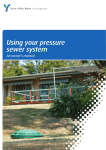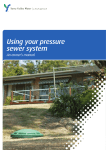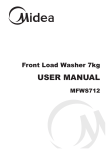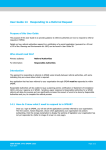Download Pressure Sewer System- Residential User Manual And Terms
Transcript
Pressure Sewer System - Residential User Manual and Terms & Conditions The Pressure Sewer System is not to be used until notification has been received from Goulburn Valley Water that the System is fully operational. Using this manual This manual is a guide to the operation and maintenance of the pressure sewer system installed on your property. The system is easy to use and it is recommended that you familiarise yourself with how it works. There are some basic things that you should know about your pressure sewer system, including: • How to care for your unit. • What happens if the alarm sounds. • Procedures to put in place before you go on holiday. Page 2 Contents Using this manual ................................................................................................. 2 What do I need to know about pressure sewer systems? .............................. 4 Why install a pressure sewer system? .................................................................................................................................. 4 What is a pressure sewer system and how does it work? ................................................................................................. 4 What components make up a pressure sewer system? .................................................................................................... 5 Typical Pressure Sewer System – Domestic Application ................................................................................................... 5 1. Pumping Unit (Goulburn Valley Water).......................................................................................................................... 5 2. Boundary Valve Kit (Goulburn Valley Water) ................................................................................................................. 5 3. House Service Line (Property Owner) ............................................................................................................................. 5 4. Control Panel (Goulburn Valley Water) .......................................................................................................................... 5 How do pressure sewer systems work? ............................................................ 6 Important information........................................................................................... 7 What items must NOT be flushed down your household drains? ..................................................................................... 7 Why can't rainwater go into the pressure sewer system? ................................................................................................... 7 Why must I keep heavy weights off the lid? ........................................................................................................................ 7 What you need to know about alarms ................................................................ 8 What happens if I want to extend my house or landscape the garden? ....... 9 Extensions to your house ...................................................................................................................................................... 9 House service line ................................................................................................................................................................... 9 Bungalows or other dwellings on your property ............................................................................................................... 9 Landscaping ............................................................................................................................................................................ 9 Garages, car parks, decking and garden sheds ................................................................................................................. 9 Installing a swimming pool or large spa ........................................................................................................................... 9 What special precautions do I need to take when going on holidays? ....... 10 Pumping unit repairs and warranties ............................................................... 11 What happens if my pumping unit needs to be repaired? ................................................................................................11 Pumping unit servicing ..........................................................................................................................................................11 Pressure sewer bursts............................................................................................................................................................11 Warranties and repair costs ....................................................................................................................................................11 Pumping unit warranty ........................................................................................................................................................... 11 Pumping unit replacement ...................................................................................................................................................... 11 Terms and Conditions – Pressure Sewer Systems ........................................ 12 Page 3 What do I need to know about pressure sewer systems? Why install a pressure sewer system? What is a pressure sewer system and how does it work? Pressure sewer systems are an economical and environmentally-friendly way of collecting, transporting and disposing of wastewater from households. A pressure sewer system is made up of a network of fully sealed pipes which are fed by pumping units located at each connected property. ultimately transfers the wastewater to the nearest wastewater treatment facility this could be within the surrounding area or many kilometres away. They are often used in areas when the landscape is either very hilly or very flat, in areas which regularly flood or have high water tables, or where it is impractical to install other types of sewerage systems. The pumping unit processes the property wastewater and transfers it to the pressure sewer located in the street via a small pipeline within the property. The pressure sewer forms part of the overall pipe network which Once installed, the only visible parts of the pressure sewer system are the tank lid and control panel, as shown in the photograph above. Conventional gravity sewers continue to be Goulburn Valley Water’s preferred option to service properties and pressure sewers will only be used where benefits on a triple bottom line basis can be demonstrated. Page 4 What components make up a pressure sewer system? The pressure sewer system on your property is made up of four key elements, as shown in the diagram below. Typical Pressure Sewer System – Domestic Application 1. Pumping Unit (Goulburn Valley Water) This includes a small pump, storage tank and level monitors which are all installed underground so that only the top of the storage tank (or lid) is visible. 2. Boundary Valve Kit (Goulburn Valley Water) Ensures that wastewater which is already in the pressure sewer cannot re-enter your property and enables maintenance staff to isolate you from the system in the event of an emergency. 3. House Service Line (Property Owner) This is a small diameter pipe (not dissimilar to a large sprinkler system pipe) which connects your property drain to the pumping unit on your property. 4. Control Panel (Goulburn Valley Water) This is a small box which is mounted to the wall of your house containing all the electrical controls for the pumping unit including both the audible and visual alarm systems. For specific sites this may include SCADA monitoring and digital timers as required. Page 5 Pressure sewer systems are an economical and environmentallyfriendly way of collecting, transporting and disposing of wastewater from households. How do pressure sewer systems work? The main component of the pressure sewer system is the pumping unit which is installed on your property. The pumping unit works in the following way: STEP 1 STEP 2 Wastewater enters the storage tank from the property drains (including sinks, toilets, showers, baths etc.). The wastewater level rises above the “pump on” level and the pump automatically turns on. PUMP OFF PUMP ON STEP 4 STEP 3 When the wastewater level is reduced below the “pump off” level, the pump automatically turns off. In the event of a power outage or pump failure, the wastewater level may rise above the “alarm level”. The audible and visible alarm will automatically be activated. PUMP OFF PUMP OFF Page 6 The storage tank lid and boundary valve kit lid must not be covered by any landscaping works. You must also ensure sufficient space is left around each of these components to enable access should it be required. Important information What items must NOT be flushed down your property drains? It is very important that the following items are NOT flushed down any of your property drains (sinks, toilets, showers, baths etc.) and into the sewerage system, whether conventional or pressure system: glass metal or metal filings seafood shells aquarium sand nappies, socks, rags or clothes plastic objects sanitary napkins or tampons kitty litter explosives flammable materials lubricating oil grease strong chemicals gasoline diesel paint rainwater Why can't rainwater go into the pressure sewer system? Pressure sewer systems are only designed to accept property wastewater, not storm water or rainwater. Rainwater must not be directed into the sewerage system for the following reasons: it will increase the costs of pumping for you; it can lead to alarms being activated; in extreme situations, the pumping unit may overflow. If the pumping unit fails due to any of the above items entering the storage tank, the customer may be responsible for meeting the cost of any repairs. If the property owner causes damage to the lid of the storage tank, the customer may be responsible for meeting the cost of any repairs. If the alarm regularly activates during or after rainfall, you should contact Goulburn Valley Water. Why must I keep heavy weights off the lid? The lid of the storage tank is not strong enough to withstand the weight of very heavy objects (greater than 500 kilograms). As a guide, the following items should be kept off the lid. cars and other vehicles ride-on lawn mowers If you are unsure about what items can go into the pressure sewer system, please call Goulburn Valley Water on 1800 454 500. The property owner is responsible for protecting all Pressure Sewer System components on their property from damage. Page 7 To turn off the audible alarm, press the button on the underside of the control panel. The flashing light will only turn off if one of our representatives resets it, or the problem which has triggered the alarm is resolved. What you need to know about alarms Why has my alarm activated? There are a number of reasons why your alarm may be activated. The following table provides you with a step-by-step guide. Please call 1800 454 500 to report any alarms. Page 8 If you are extending your building, you must contact us to seek advice on the suitability of your existing pumping unit prior to any construction activities. What happens if I want to extend my house or landscape the garden? Extensions to your house If you are extending your building, you must contact Goulburn Valley Water to seek advice on the suitability of your existing pumping unit prior to the commencement of any construction activities. Moving the pumping unit will be dependent on the layout of your land as all wastewater from your house must gravitate into it. If we approve your application, the costs associated with moving the pumping unit and house service line will be your responsibility. Any changes to the original installation need to be clearly documented and submitted to us to ensure that in the event of an emergency our maintenance staff can locate the key system components. House service line The house service line is a polyethylene sewer pipe which connects the pumping unit on your property to the pressure sewer in the street. It is worth familiarising yourself with the exact location of the house service line so that it can be moved (if required) or avoided if work is being done on your property. The house service line can be found using one of the following methods: • detectable marker tape is buried just above the pipeline and can be located by your builder • if your builder cannot detect the tape, contact us on 1800 454 500 and an officer will peg the line for you at a cost. Bungalows or other dwellings on your property It may be possible for your pumping unit to service both the main and additional dwellings on your property, depending on the layout of your land. Please contact us for advice in relation to this matter. Landscaping Landscaping over the house service line is permitted, please bear in mind that if repairs are required, you will be responsible for the costs of any reinstatement works to repair any damage caused. The storage tank lid and boundary valve kit must not be covered by any landscaping works. You must also ensure that sufficient space is left around each of these components to enable our maintenance staff to access them if required. Garages, car parks, decking and garden sheds Garages, car parks, decking and garden sheds are not to be built over the pumping unit or boundary valve kit. Goulburn Valley Water approval is required to build any of these structures over the house service line. Installing a swimming pool or large spa Installing a swimming pool or large spa can result in large amounts of water being discharged quickly to the pumping unit during activities such as backwashing filters or emptying. In some cases, the pumping unit may not be able to cope with this and the alarm may activate or the pumping unit may even overflow. This could include upgrading from the standard pump unit and installation of dual pumps, larger well or storage tank. Any costs associated with an upgrade from the standard unit are to be borne by the property owner. Please contact us for advice in relation to this matter. If you are thinking about installing a swimming pool or spa, contact us and we will provide advice on how to avoid potential problems. Page 9 What special precautions do I need to take when going on holidays? Going on holidays If you are going on holidays for more than three days, your pumping unit will need to be flushed out to prevent potential odour problems. It is suggested that you complete the following activities before going away: Flush the system Always keep the power to the pumping unit on Run at least 190 litres of water into your household drains in order to activate the pressure sewer pump. This can be achieved by filling a bathtub and then emptying it, or doing a couple of loads of washing and using the shower just prior to going on holiday. If there are any leaking taps or appliances within your household, there may be a small accumulation of wastewater in the storage tank. If the pumping unit is turned off, it could potentially overflow and there would be no audible or visible alarm to warn you or your neighbours of the problem. Flush the system by filling the bathtub and then emptying it Ensure the pumping unit is turned on at all times If you fail to clean your system before going on holidays and we have to flush out your storage tank in response to complaints from residents in the area, you may be required to pay for the cost of this work. Page 10 If you are thinking about installing a swimming pool or spa, contact us and we will provide advice on how to avoid potential problems. Pumping unit repairs and warranties What happens if my pumping unit needs to be repaired? Pumping unit repairs are generally simple. In most cases, maintenance staff will be able to make immediate repairs to your pumping unit. If the problem is more serious, your pumping unit may be replaced immediately and taken back to our workshop for repairs. Following this, try to minimise water usage until the problem is fixed. Pumping unit servicing Warranties and repair costs The average pumping unit only requires servicing once every eight years. Pumping unit warranty Please report any pumping unit faults to us. Pressure sewer bursts If you notice wet ground or water escaping from your plumbing, it is possible that a burst may have occurred. Such breaks are rare and are more likely to occur due to other work being carried out near the pipes. If you become aware of such a fault, please contact us on 1800 454 500 immediately. Only our licensed representatives carry out repairs on the pumping unit. Work by others that was not authorised by us in writing may void warranties and you may become liable for future costs. Pumping unit replacement If pumping units require replacement, you will not be required to meet any of these costs. The only exceptions to this rule are if you have: • emptied substances into the pumping unit which are banned as shown earlier • accessed the pumping unit. The storage tank lid must remain sealed at all times and warranties are exempt if you open it • interfered with the house service line or boundary valve kit • blocked off the vents to the storage tank by covering it over. Page 11 Terms and Conditions – Pressure Sewer Systems 1. Consent to Connection The consent of Goulburn Valley Region Water Corporation (“GVW”) to connect the Property to the sewerage system pursuant to Section 145 of the Water Act 1989 is subject to: 1.1 These Terms and Conditions for Connection (“Terms and Conditions”). 1.2 In respect of the Property, the Owner, other details and subject to any special requirements, detailed in the Consent Notice attached (“Consent Notice”) which forms part of these Terms and Conditions. 1.3 That the Terms and Conditions of this consent are binding on the Owner and on future owners of the Property. 1.4 Connection via a pressure sewer system (“PSS”) which means the pressure sewer system shown in the User Manual including the pumping unit, control panel, electrical cables, capped inspection opening, boundary valve kit, storage tank, internal sewer rising main and associated pipes. 1.5 The Property Owner must submit an “Application for Connection – Pressure Sewer System” to GVW. 1.6 Upon approval, GVW will issue a “Consent Notice for Connection – Pressure Sewer System” to the Property Owner. 2. Other Relevant Documents/Agreements Incorporated in these Terms and Conditions (as applicable) are: 2.1 The GVW Customer Charter for residential customers or business customers. 2.2 The obligations set out in the User Manual for Pressure Sewer adopted by GVW as applying from time to time (available on GVW’s website). 2.3 Any applicable Australian Standards and Water Services Association of Australia standards. 2.4 Any Trade Waste Agreement, Developer Construct Agreement or Agreements under Section 173 of the Planning and Environment Act 1987 and Section 17(2)(c) of the Subdivision Act 1988 made with GVW applying to the Owner or the Property. 3. Property Drain The Owner must arrange a licensed plumber (at the Owner’s cost) to install or alter the property drain for connection to the PSS to GVW’s satisfaction. The Owner is responsible for the cost of the works in accordance with these Terms and Conditions. 4. Installation 4.1 The Owner must arrange to install a PSS of a system make, brand or type (including all its constituent components) to the satisfaction of GVW. This detail will be set out in the Consent Notice. 4.2 The PSS control panel must be mounted on the side of a building on the Property or other structure suitable to GVW and is to be connected to the electrical power supply to the Owner’s Property. 4.3 The isolation valve in the boundary connection kit is not to be opened until GVW has issued a Compliance Notice for Pressure Sewer System and approved connection. Page 12 5. Property service plan 5.1 Prior to connection, the Owner must arrange for a licensed plumber (at the Owner’s cost) to lodge a property service plan for approval by GVW specifying the location of all infrastructures, including: 5.1.1 Location of the pump unit, control box, interconnecting cables and boundary valve kit. 5.1.2 Alignment of the internal sewer rising main. 5.1.3 Gravity property service drain and all fixture units. 5.2 Following approval of the property service plan, the layout of the PSS must not be altered without GVW’s written consent. 6. Ownership and Occupation 6.1 After approval and connection of the PSS to the Corporation’s reticulated system, GVW will own the PSS. 6.2 The Owner will continue to own the property drain. 6.3 The Owner must ensure any occupier of the Property is aware of the existence of the PSS and a copy of these Terms and Conditions and the User Manual are provided. The Owner remains liable for all aspects of these Terms and Conditions and the User Manual regardless of the occupation of the Property by any other party. 7 Maintenance and Damage 7.1 The Owner must arrange to maintain the property drain and keep it in good working order. Any work on the property drain must be carried out by a licensed plumber (at the Owner’s cost). 7.2 GVW will maintain the PSS. 7.3 The Owner must ensure GVW is promptly advised of any alarms (including power failures) or faults with the pump unit control panel or electrical cables and pipes on GVW’s side of the inspection opening. The GVW emergency and faults telephone number is Freecall 1800 454 500. 7.4 The Owner is responsible for protecting the PSS. Any damage to the PSS is to be reported to GVW for repair by GVW at the Owner’s cost. 7.5 The Owner must allow GVW staff to enter the Property to maintain the PSS system as required. 8. Power The Owner is responsible for paying for the power consumption of the PSS. 9. Pools and spas or increase in discharge flowrate If the Property includes a pool or spa, or any other property improvements, which discharges water at more than 0.5 litres per second to the PSS, the Owner must limit the flow by installing any of the following: 9.1 An intermediate holding tank. 9.2 A duplex pump arrangement. 9.3 A flow limiting valve. 9.4 Other device. Such installation must be carried out to the satisfaction of GVW by a licensed plumber (at the Owner’s cost). Page 13 10. Restricting water use 10.1 In any case where the Owner discovers a fault with the PSS (including any power failure) or the Owner’s property drain, the Owner must restrict as much as possible the amount of water that is discharged to the Owner’s property drain. 10.2 The Owner must only discharge appropriate waste into the PSS that will not damage the PSS, the pump unit or other GVW infrastructure. The cost of any repairs caused by discharging inappropriate waste material through the PSS must be paid by the Owner. 11. User Manual The Owner must ensure that a copy of the User Manual and Terms and Conditions are kept at the Property at all times, even if the Property is leased or rented. 12. Decommissioning old systems When the PSS is installed, the Owner must arrange for a licensed plumber (at the Owner’s cost) to decommission any existing waste water system, in accordance with any Environment Protection Authority and other regulatory requirements for such work. 13. Selling the Owner’s Property These Terms and Conditions and the User Manual must be brought to the attention of any prospective purchaser of the Property by the Owner. 14. Costs and charges 14.1 The Owner is responsible for the costs of purchasing the PSS, installing the PSS and GVW’s associated administrative costs. 14.2 The Owner must meet all sewerage service and usage charges which apply to the Property. 14.3 The Owner must meet all costs incurred by and charges levied by GVW in respect of the repair or replacement of the PSS where this is necessary as a result of damage caused either intentionally or negligently by the Owner. 14.4 The Owner must meet any New Customer Contribution charges and any applicable connection fees at the time of connection. 14.5 The Owner must gain approval from GVW to relocate any components of the PSS on the Property and then only by an approved licensed plumber (at the Owner’s cost). 15. Procedure for payment - Existing works charge paid 15.1 If the cost for installation of the PSS has already been paid to GVW as a charge in respect of the development of the Property then: 15.2 Prior to connection, the Owner must arrange and provide GVW with a quote for the installation of the PSS from the approved contractor that has current installation accreditation with the approved system supplier. If the quote is acceptable, GVW will advise the Owner. If GVW requires further quotes, the Owner agrees to obtain them. GVW will raise a Purchase Order and submit to the approved contractor for supply. 15.3 The invoice (including reference to the Purchase Order) for the installation of the PSS is to be forwarded to GVW together with the As Constructed Drainage Plan prepared by the approved contractor for the installation of the PSS. Page 14 16. Procedure for payment - Existing works charge not previously paid 16.1 If the cost for installation of the PSS has not already been paid to GVW as a charge in respect of the development of the Property then: 16.2 Any invoice in respect of the design, materials or installation of the PSS which may be payable by GVW must be paid by the Owner, either through GVW or direct to any party rendering the invoice, and within 7 days of providing the invoice to the Owner. 16.3 Within 7 days of receiving notice from GVW to do so, the Owner must make payment of any amounts payable pursuant to Clause 16.1 plus an additional 30% to cover GVW’s internal administration costs. 17. Odour control Any relevant feasibility reports required by GVW must address the generation of odour from the PSS in order to mitigate odours to GVW’s satisfaction (at the Owner’s cost). 18. Flow meters The Owner agrees to install flow meter(s) on the discharge from: 18.1 All commercial and large residential developments to GVW’s satisfaction. 18.2 Any sewer rising main that is greater than 1 km in length and discharges directly into a sewerage pump station. 19. Supervisory Control and Data Acquisition (“SCADA”) monitoring If GVW requires, the Owner agrees to install a telemetry system to provide a communication link into GVW’s SCADA, to GVW’s satisfaction. 20. Easement If GVW requires, the Owner agrees to set aside on the plan of subdivision or to create any easements over the Property in favour of GVW in relation to the PSS, to GVW’s satisfaction. 21. Non-Compliance with Terms and Conditions 21.1 Any breach of these Terms and Conditions by the Owner or any occupant of or visitor to the Property, without limiting the remedies available to GVW, will allow GVW to do any or all of the following: 21.1.1 Require the Owner to take specified actions to remedy the breach. 21.1.2 Refuse to accept discharges from the PSS into GVW’s reticulated sewer system until the breach is remedied. 21.1.3 Exercise any powers available to GVW under the Water Act 1989. 21.1.4 Revoke GVW’s consent for the connection pursuant to Section 145 of the Water Act 1989 and disconnect the PSS. Page 15 Additional information For further information, please contact Goulburn Valley Water General Enquiries: (03) 5832 0600 Emergencies and Faults: 1800 454 500 E-mail: [email protected] Website: www.gvwater.vic.gov.au Translator and Interpreter Service: 131 450


























